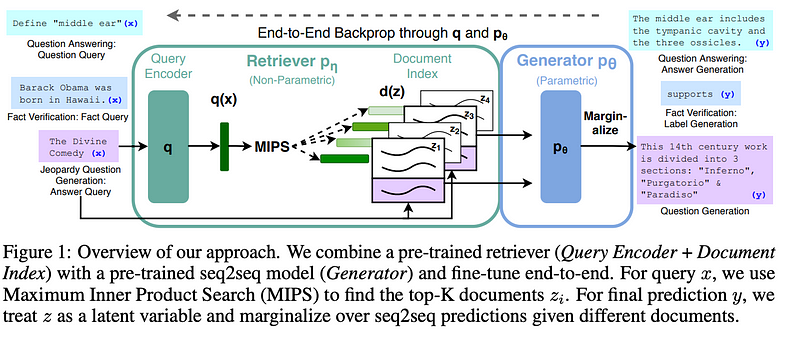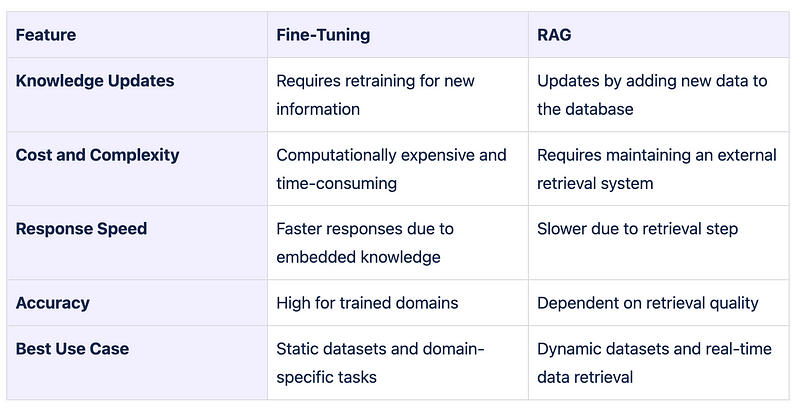RAG vs. Fine-Tuning : When to Use, Combine, and Optimize for Best Results
When building or optimizing AI models, two powerful techniques often come into play: Fine-tuning and RAG (Retrieval-Augmented Generation)…

When building or optimizing AI models, two powerful techniques often come into play: Fine-tuning and RAG (Retrieval-Augmented Generation). While both approaches enhance model performance, they achieve this in different ways and are suitable for different scenarios. In this post, we’ll explore the strengths and weaknesses of each method, discuss when and why you might choose one over the other, and highlight the benefits of combining them.
What Are RAG and Fine-Tuning?

RAG (Retrieval-Augmented Generation)
RAG augments a model’s generation capability by combining it with a retrieval system. Instead of relying solely on pre-trained knowledge, RAG searches an external database or knowledge base for relevant information in real-time and uses it to generate responses.
How It Works:
- A retrieval system fetches documents or data from a vector database or index.
- The retrieved information is passed to the model, which generates context-aware responses.
Key Benefits:
- Provides up-to-date, real-time information by pulling from external sources.
- Eliminates the need to retrain the model for every new piece of information.
- Scales efficiently for large datasets.
Limitations:
- Dependent on the quality and accuracy of the retrieval system.
- Slower response times due to retrieval steps.
- Requires additional infrastructure to manage the database or index.
Fine-Tuning
Fine-tuning involves training a pre-trained model further on a specific dataset to tailor its responses to a particular domain, style, or task.
How It Works:
- The model’s parameters are adjusted based on a smaller, domain-specific dataset.
- The fine-tuned model generates answers based on the knowledge embedded during training.
Key Benefits:
- Optimized for specific domains and styles (e.g., legal, medical, or technical).
- Generates fast, consistent responses without relying on external systems.
- Works well for static datasets where knowledge updates are infrequent.
Limitations:
- Fine-tuning requires time, computational resources, and high-quality datasets.
- Difficult to update the model once fine-tuned (e.g., for new laws or real-time data).
- Can be costly if the dataset is large or frequently changing.
When to Use RAG or Fine-Tuning
RAG is Best for:
Dynamic or Frequently Updated Data: RAG excels when working with datasets that are updated often, such as news, real-time financial data, or changing regulations.
Broad and Diverse Knowledge: Ideal when the scope of information is too vast to be embedded into the model (e.g., customer support knowledge bases).
Real-Time Use Cases: Perfect for situations where users need the latest information or context-aware responses.
Fine-Tuning is Best for:
Domain-Specific Knowledge: If you need the model to deeply understand a specific field, like legal codes, technical manuals, or academic knowledge, fine-tuning ensures that expertise is embedded into the model.
Consistent and Predictable Outputs: Fine-tuning is ideal when you need uniformity in responses across a specific domain or task.
Static Knowledge: Works well for datasets that do not change frequently (e.g., core legal principles or fundamental scientific facts).
Why Combine Fine-Tuning and RAG?
In many cases, combining Fine-Tuning and RAG can provide the best of both worlds, offering both domain-specific expertise and real-time adaptability. Here’s why:
Advantages of Combining Fine-Tuning and RAG:
- Domain-Specific Expertise with Current Data:
- Fine-tuning equips the model with foundational knowledge (e.g., legal principles).
- RAG supplements this with real-time or frequently updated data (e.g., recent case law or policy changes).
2. Improved Response Quality:
- Fine-tuned models can answer common questions or follow specific styles effortlessly.
- RAG fills in gaps by retrieving detailed or less common information.
3. Scalability:
- Fine-tuning reduces the need for the retrieval system to process basic questions.
- RAG focuses only on questions requiring additional context.
When to Combine Fine-Tuning and RAG
1. Legal Domain:
- Fine-tune the model on legal fundamentals (e.g., civil law, contract law).
- Use RAG to retrieve recent legal rulings, amendments, or jurisdiction-specific details.
2. Customer Support:
- Fine-tune on frequently asked questions (FAQs) to handle common queries efficiently.
- RAG fetches dynamic or product-specific information from an updated knowledge base.
3. Educational Tools:
- Fine-tune on core curriculum content (e.g., textbook material).
- Use RAG to pull in additional references, articles, or study guides.
Should You Fine-Tune, Use RAG, or Both?
Choose Fine-Tuning if:
- Your dataset is relatively static.
- You need a lightweight, self-contained solution without external dependencies.
- Uniformity and speed are critical.
Choose RAG if:
- Your data updates frequently, or you require access to large, diverse datasets.
- Real-time accuracy is a priority.
- You’re okay with additional infrastructure for retrieval systems.
Combine Fine-Tuning and RAG if:
- You want to maximize both consistency and adaptability.
- Your use case involves a mix of static and dynamic data.
- Scalability and flexibility are critical for your system.
Conclusion
Fine-Tuning and RAG are not mutually exclusive; they complement each other beautifully when applied strategically. While Fine-Tuning ensures your model is tailored for specific tasks, RAG enhances it with the ability to pull in relevant, up-to-date information. Together, they can create a robust and versatile solution that delivers consistent, accurate, and real-time responses across a wide range of applications.
Whether you choose Fine-Tuning, RAG, or a combination of both, understanding your dataset, use case, and user needs is the key to unlocking the best possible performance from your AI system.
